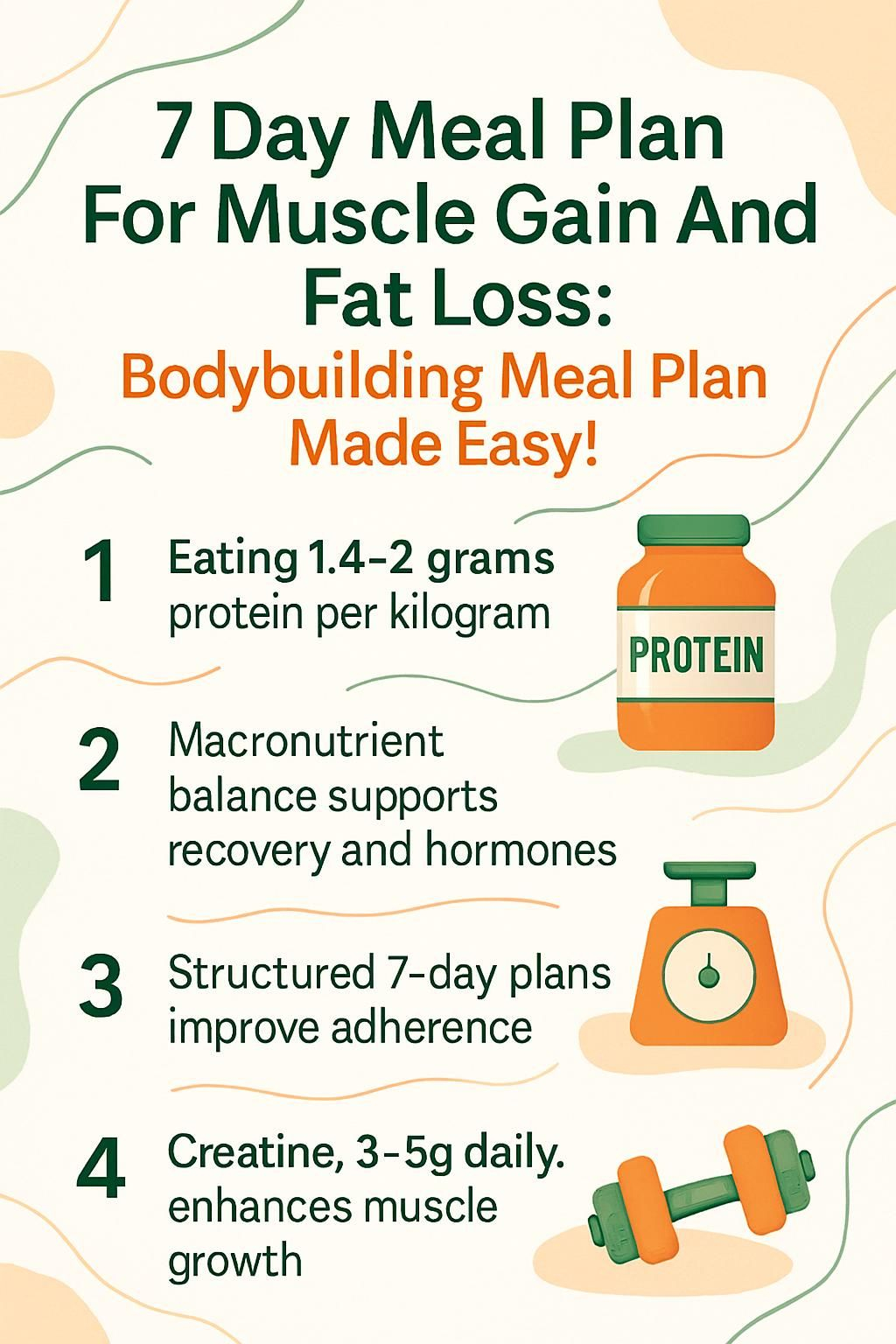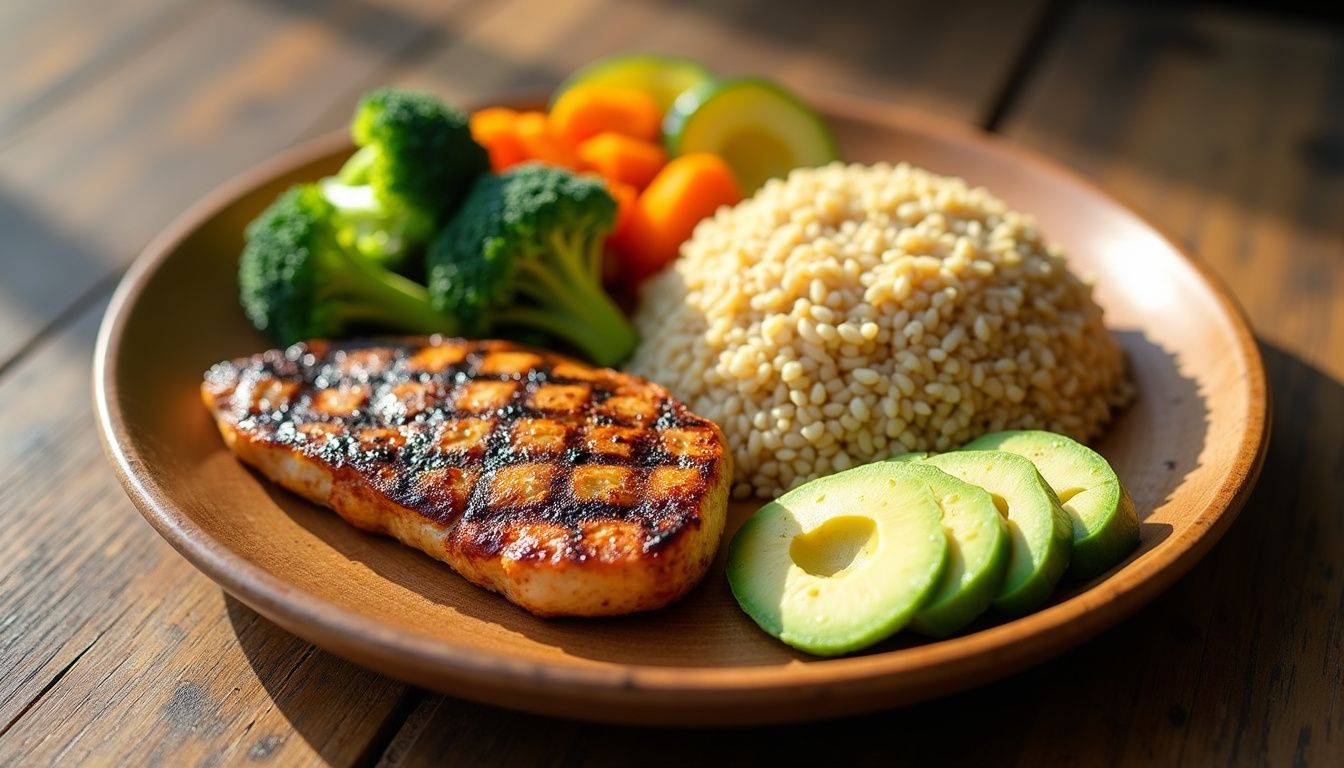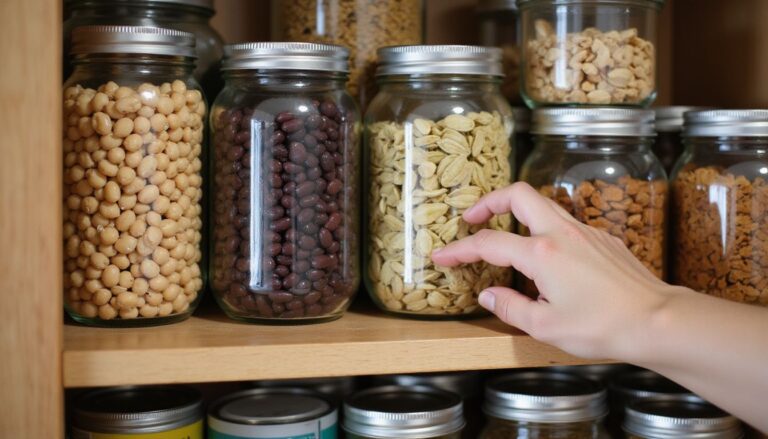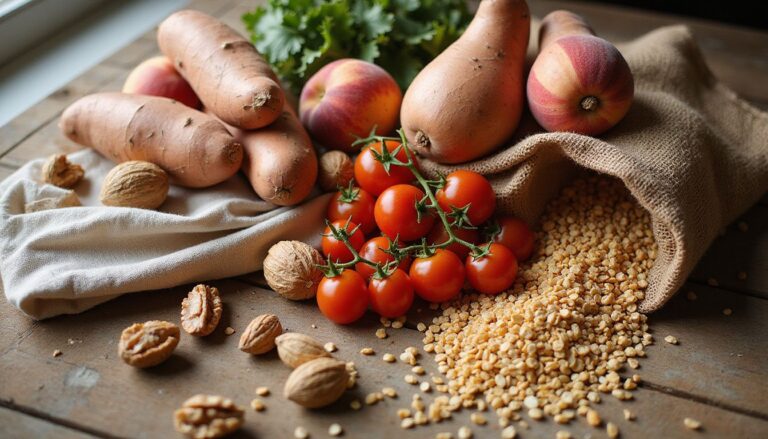7 Day Meal Plan For Muscle Gain And Fat Loss: Bodybuilding Meal Plan Made Easy!
Our Nutrition Assistant AI Suite will transform your body. You will lose fat, get toned, and build muscle. Gain confidence and optimal health.
Trying to build muscle while you lose fat can feel confusing. You need enough food to grow, yet not so much that body fat climbs. A structured meal plan gives you a simple path to follow.
Research shows a focused bodybuilding meal plan speeds progress for muscle gain and fat loss. This guide outlines a practical 7-day meal plan that uses everyday foods, clear portions, and time-saving prep. You will see what to eat, why it works, and how to stick with it for a full week.
Use this plan to fuel training, protect muscle, and keep hunger under control.
Key Takeaways
- Daily protein needs for muscle growth are 1.4 to 2.0 grams per kilogram of body weight, based on the International Society of Sports Nutrition.
- A smart macro split supports results: carbohydrates 45 to 65 percent of calories, fats 20 to 35 percent, protein 10 to 35 percent, per the Dietary Guidelines for Americans.
- Weekly structure improves consistency: batch-cooked proteins, complex carbs like oats, sweet potatoes, and brown rice, plus plenty of vegetables.
- Evidence-backed supplements help: whey protein, creatine 3 to 5 grams per day, BCAAs, and omega-3 fatty acids for recovery and performance.
- Avoid calorie extremes. Track intake so you do not gain extra fat or lose muscle during a bodybuilding meal plan.

Why is nutrition essential for muscle gain and fat loss?

Think of nutrition as the training partner that never misses a session. It powers workouts, drives recovery, and shapes body composition.
To gain lean muscle, you need a slight calorie surplus. That extra energy helps repair training stress and supports muscle hypertrophy, which is the growth of muscle fibers. For fat loss, create a modest calorie deficit while keeping protein high so you protect muscle tissue.
Balanced macronutrients, protein, carbohydrates, and healthy fats, support training and long-term health. Dietary Guidelines for Americans recommend a nutrient-rich pattern that improves energy, recovery, and well-being. Protein repairs tissue. Carbs fuel hard sets. Fats support hormones linked to progress.
Nutrition is the foundation of effective bodybuilding, as every meal shapes your ability to build lean muscle while losing unwanted fat.
I used to skip breakfast before early lifts and felt sluggish. Swapping in simple protein-rich meals like eggs or Greek yogurt with fruit turned my sessions around. Energy improved and recovery felt smoother.
Key components of a bodybuilding meal plan
A bodybuilding meal plan focuses on the right calories and macronutrients so your body can build muscle and drop fat efficiently.
What are calories and macronutrients?
Calories are units of food energy. They power everyday movement and exercise, and support repair after training. Calories come from three macronutrients, protein, carbohydrates, and fats.
Adjust calorie intake based on your goal. A lean bulk needs a small surplus. A cut requires a small deficit so you lose fat but protect muscle. Protein builds and repairs tissue. Carbohydrates like brown rice, oats, or sweet potato provide training fuel. Healthy fats from olive oil, avocado, nuts, and seeds support hormones.
The Dietary Guidelines for Americans suggest 45 to 65 percent of calories from carbs, 20 to 35 percent from fats, and 10 to 35 percent from protein. Fat has more calories per gram than protein or carbs, so it helps you reach targets when appetite is low.
Why is protein important for muscle growth?
Protein supplies amino acids, the building blocks your body uses to repair and grow skeletal muscle. Muscle protein synthesis rises when you eat enough protein and train with resistance.
The International Society of Sports Nutrition recommends 1.4 to 2.0 grams of protein per kilogram of body weight each day. For someone at 165 pounds, about 75 kilograms, that is 105 to 150 grams daily.
Complete protein sources include eggs, poultry, lean beef, fish, dairy, and soy foods such as tofu and tempeh. Blended plant protein powders can also provide a complete amino acid profile. Aim to include protein at each meal and snack to support recovery and muscle gain.
Muscle growth depends on consistent protein intake, proper training, and balanced nutrition, says the International Society of Sports Nutrition.
How do carbohydrates provide energy?
Carbohydrates break down into glucose, the quick fuel your body uses for movement and thinking. During hard training, muscles rely on stored carbs called glycogen for power.
Experts recommend 45 to 65 percent of calories from carbs to support both performance and body composition. On a 3,000 calorie plan for building lean muscle, this equals roughly 412 grams of carbs per day. Choose sources like oatmeal, fruit, beans, brown rice, and whole grain pasta to refill glycogen and keep energy steady.
What role do healthy fats play in hormonal balance?
Healthy fats help your body make key hormones such as testosterone and estrogen. These hormones influence strength, recovery, and body composition. Sources include avocado, extra virgin olive oil, nuts, seeds, and fatty fish.
A range of 15 to 30 percent of calories from fat works well for most lifters. This supports hormone production and provides a calorie-dense way to meet energy needs during a bodybuilding diet plan. Many athletes notice better energy and joint comfort when they include sources like nuts and avocado.
Benefits of following a structured 7-day meal plan
A clear weekly plan removes guesswork and keeps you consistent. Consistency drives results.
How does it support muscle growth and recovery?
Planned meals make it easier to hit daily protein targets, often 1.6 to 2.2 grams per kilogram of body weight. Spreading protein across the day can support muscle protein synthesis. For many people, eating every 3 to 4 hours works well.
Post-workout meals that include 20 to 30 grams of protein plus moderate carbs support recovery. Strength training paired with balanced meals and sleep improves performance and resilience, as shown in peer-reviewed research.
How does it promote fat loss?
A 7-day plan helps you set a small calorie deficit so you drop body fat while keeping muscle. High protein intake preserves lean tissue during dieting. A goal of at least 1.6 grams per kilogram is often protective during cuts.
Calorie cycling, slightly higher calories on heavy training days and slightly lower on rest days, may improve adherence. Filling, nutrient-dense foods like lean meats, eggs, beans, lentils, yogurt, and vegetables help control hunger without excess calories.
How does it simplify meal preparation?
Batch cooking removes daily stress. Prepare proteins in larger amounts, cook staple carbs in bulk, and pre-chop vegetables. Store food in BPA-free containers, then assemble meals in minutes.
Ready snacks, for example trail mix, hard-boiled eggs, cottage cheese, or sliced veggies with hummus, keep you on plan. Meal prep saves time, reduces takeout, and helps you hit protein and calorie targets more consistently.
Which foods should you include in your meal plan?
Whole foods support training, recovery, and health. Build meals around protein, complex carbs, healthy fats, and vegetables.
What are good high-protein foods like chicken, fish, eggs, and tofu?
Skinless chicken breast offers about 30 grams of protein per 100 grams. Fish such as salmon and tuna provide 20 to 25 grams per serving and include healthy fats. Eggs contain about 6 grams each and deliver all essential amino acids your body cannot make on its own.
Tofu and other soy foods supply 8 to 15 grams per serving and work well for a plant-based diet. Dairy, such as Greek yogurt and low-fat milk, adds calcium for bone health. Beans and lentils bring protein and fiber for gut health.
Whey protein isolate has less lactose, which may suit people with mild intolerance. I often rotate tofu stir fry with edamame, grilled chicken salads, and tuna on whole grain toast. Pair these with complex carbohydrates like sweet potatoes or brown rice for complete meals.
Which complex carbohydrates are best: sweet potatoes, brown rice, oats?
Sweet potatoes digest slowly and provide steady energy. One cup has around 27 grams of carbs plus fiber and vitamin A. This helps you feel full, which supports fat loss.
Brown rice offers whole grain benefits and about 45 grams of carbs per cup. Oats are rich in fiber and support steady blood sugar. One cooked cup contains about 28 grams of carbs and adds volume without much fat. These carbs refill glycogen and fuel heavy training.
What healthy fats should you eat, such as avocado, olive oil, and nuts?
Avocado supplies monounsaturated fat and helps absorb fat-soluble vitamins from vegetables. Extra virgin olive oil works well for dressings and drizzling over cooked foods. Nuts and seeds, such as almonds, walnuts, chia, and pumpkin seeds, add calories, vitamin E, magnesium, and essential fatty acids.
Aim for fats to make up 15 to 30 percent of your calories. If you need more calories to gain weight, add fats like nut butters, cheese, and avocado. These foods keep you satisfied and support hormones that influence muscle growth.
Why include vegetables for fiber and micronutrients?
Vegetables provide fiber for hunger control and digestive health. Eating high-fiber foods such as broccoli, leafy greens, and green beans can lower total calories while keeping meals filling.
They also supply vitamins and minerals that support muscle function, for example iron and magnesium in spinach. The U.S. Department of Health and Human Services recommends a variety of vegetables each day. Adding more colorful vegetables helped me reduce snacking between meals.
Sample 7-day meal plan for muscle gain and fat loss
This sample 7-day meal plan balances protein, carbs, and fats so you can build muscle while you lose fat. Pick portions that match your calorie needs.
What balanced meals and snacks are ideal on Day 1?
Breakfast: Greek yogurt with mixed berries and a small handful of granola. High-quality protein plus fiber supports satiety and recovery.
Lunch: Chicken and vegetable quinoa bowl. Quinoa brings carbs and extra protein. Add olive oil for healthy fats.
Dinner: Lean steak with a baked sweet potato and steamed greens. Steak provides essential amino acids for growth. Sweet potatoes supply vitamins and complex carbs.
Snacks: Cottage cheese with pineapple or an apple with peanut butter. These choices support muscle repair and steady energy.
What makes a high-protein breakfast and post-workout nutrition on Day 2?
Breakfast: Oats cooked with milk, stirred with whey protein, banana slices, and a spoon of peanut butter. This delivers more than 25 grams of protein with complex carbs and healthy fats.
Post-workout: Protein smoothie with whey, mixed berries, and unsweetened almond milk. Whey digests quickly to support recovery. Berries add antioxidants that help manage exercise stress.
How to create nutrient-dense meals with variety on Day 3?
Breakfast: Veggie omelet with whole wheat toast. Eggs bring complete protein. Whole grains support lasting energy.
Lunch: Beef stir fry with bell peppers and broccoli over brown rice. This refills glycogen and adds fiber and micronutrients.
Dinner: Shrimp salad with avocado, tomatoes, and a light olive oil dressing. Protein plus healthy fats aid satiety.
Snacks: Greek yogurt with almonds or a small trail mix. Dried fruit with nuts offers quick energy in the afternoon without excess sodium.
How to incorporate plant-based protein options on Day 4?
Breakfast: Tofu scramble with mixed vegetables and whole grain toast. Tofu provides a complete amino acid profile.
Lunch: Tempeh and quinoa bowl with spinach and roasted carrots. Together they deliver high-quality plant protein and fiber.
Dinner: Lentil and sweet potato stew with a side salad. One cooked cup of lentils offers about 18 grams of protein.
Snacks: Edamame or hummus with carrot sticks. Mixing soy, legumes, and grains across the day helps you get complete protein on a plant-based plan.
What should you focus on for recovery and hydration on Day 5?
Recovery is the goal. Choose meals that pair lean protein, such as fish or chicken, with complex carbs like brown rice or sweet potatoes.
Hydration matters. Aim for about 13 cups of water per day for men or 9 cups for women. Include electrolyte-rich foods, such as leafy greens, bananas, and berries. A post-workout protein shake can support muscle repair. Healthy fats from avocado or nuts aid hormone support.
How to rotate flavors to avoid burnout on Day 6?
Keep prep the same, change the flavor. Use different spice blends and sauces on your batch-cooked proteins. Try Mediterranean herbs on chicken, soy-ginger on tofu, or chili-lime on fish.
Rotate produce. Swap broccoli for bell peppers, or switch sweet potatoes for brown rice. Add one new ingredient this week, for example avocado on toast or a different nut in your salad. Vary cooking methods, roasting, grilling, or steaming, for fresh textures.
How does calorie cycling support fat loss on Day 7?
Calorie cycling means lowering calories slightly on a rest day while keeping protein high. Fill your plate with high-fiber foods like leafy greens, cucumbers, and berries so you feel full with fewer calories.
Choose lean proteins like grilled chicken, fish, or tofu and include a small amount of healthy fats like avocado or peanut butter. On my last lower-calorie day, I swapped toast for extra vegetables and made an egg white omelet with spinach. Energy stayed steady while calories dropped.
How can you prep meals effectively?
Simple routines make your week easier. Prep food once, eat well all week.
What are the best methods for batch cooking proteins and carbs?
Cook lean proteins in bulk. Grill, bake, or air-fry chicken breasts. Hard-boil eggs and peel them for convenience. Make tuna salad with Greek yogurt or olive oil. Steam and pan-sear tempeh so it keeps texture for days.
Cook brown rice and oats in a rice cooker. Roast sweet potatoes on sheet pans, then portion. Pre-chop vegetables and store them in airtight bags. With ready proteins and carbs, you can assemble balanced meals in minutes.
How do meal prep containers help?
Meal prep containers keep food fresh and easy to track. BPA-free options are safe and durable. Use separate containers for proteins, carbs, and vegetables. This makes mixing and matching simple while controlling portions.
Pre-portioned meals save time during busy weeks. During my first bodybuilding show prep in 2023, having planned containers cut down on takeout and kept my macros consistent.
How to plan snacks for convenience?
Set aside time to portion high-protein snacks. Good options include hard-boiled eggs, cottage cheese cups, jerky, hummus with sliced vegetables, trail mix, and protein bars.
Store shelf-stable items in your gym bag or desk. Keep a ready-to-mix protein shake with fruit for post-workout. Prepared snack packs reduce decision fatigue and protect your daily targets.
Which supplements support your meal plan?
Supplements can fill gaps in a solid nutrition plan. Choose products with strong research support, and talk with a healthcare professional if you have medical conditions or take medication.
How does whey protein help?
Whey protein is a complete protein that digests quickly. It delivers all nine essential amino acids and supports muscle repair and growth. Studies show post-workout whey speeds recovery and helps build lean muscle, especially if your diet is low in protein.
Common forms include isolate, lower in lactose and calories, and concentrate, higher in lactose. A fast shake can help you hit your protein goal on busy days.
What are the benefits of creatine?
Creatine monohydrate supports strength and muscle mass gains during resistance training. It increases phosphocreatine in muscles, which helps produce quick energy for short, intense efforts.
Research shows 3 to 5 grams per day improves performance and recovery for most healthy adults. Many lifters report measurable gains in size and power within a few weeks.
Why take BCAAs (Branched-Chain Amino Acids)?
BCAAs are three essential amino acids, leucine, isoleucine, and valine. They can reduce muscle breakdown and soreness during calorie deficits or high training volume. Some people also note less fatigue during exercise.
These supplements work best alongside a diet rich in complete proteins. I noticed less soreness between sessions when I added a BCAA drink to a high-protein meal plan.
…
¹ Wolfe RR. Branched-chain amino acids and muscle protein synthesis in humans: myth or reality? J Int Soc Sports Nutr (2017).
² Blomstrand E et al., Administration of branched-chain amino acids during sustained exercise… Acta Physiol Scand (1991).
³ Morton RW et al., A systematic review… Br J Sports Med (2018).
What role do omega-3 fatty acids play?
Omega-3s help reduce inflammation and may support recovery and joint comfort. Sources include fish oil, salmon, flaxseeds, chia seeds, and algae-based supplements.
They also support heart health and may help maintain healthy testosterone levels. Eating fish twice a week or taking a daily supplement with at least 1 gram of EPA and DHA can make training feel better.
What common mistakes should you avoid?
A few habits can stall progress. Avoid these and your results improve faster.
Why is overeating or undereating calories a problem?
Eating far above maintenance calories often leads to extra fat gain. A moderate surplus of 10 to 20 percent is enough to build muscle with less fat gain. Going much higher creates work you must undo later.
Eating too far below maintenance can cause muscle loss, low energy, slow recovery, and hormonal issues. I felt drained when I cut too hard and my lifts suffered. Set clear calorie targets to match your goal.
What happens if you neglect post-workout nutrition?
Skipping post-workout food slows recovery and limits muscle protein synthesis. A target of 20 to 30 grams of protein with moderate carbs after training is supported by sports nutrition research from 2017.
Missing this window can increase soreness and reduce performance in the next session. On days I skipped my shake and carbs, I felt more aches and struggled to match my usual weights.
Why is meal variety important?
Eating the same meals every day can cause boredom and lower adherence. Research shows that limited variety often leads to diet dropout. Rotate proteins, carbs, vegetables, and seasonings to keep meals interesting.
Diverse foods also supply a wider range of vitamins, minerals, and fiber. Small changes, like new spices or a different vegetable, can boost enjoyment and consistency.
Frequently Asked Questions
These quick answers help you start strong with your 7-day meal plan.
Can beginners follow this meal plan successfully?
Yes. Beginners often do well with a 7 day meal plan for muscle gain and fat loss. Adjust portions to your calorie and protein needs. If you have health issues, speak with your doctor or a registered dietitian before starting.
I began as a beginner too. Tracking protein and using planned meals removed guesswork and kept me on track.
How do you adjust portions for specific goals?
For muscle gain, eat a calorie surplus and set protein at 1.6 to 2.2 grams per kilogram of body weight. Carbs can range from 3.5 to 5 grams per kilogram, and fats from 0.5 to 1.5 grams per kilogram. Use a food scale to keep portions consistent. Add rice, extra chicken, or a snack if you need more calories.
For fat loss, lower overall calories while keeping protein high. Reduce carbs and fats gradually inside those ranges. A tracking app, weekly weigh-ins, and progress photos help you adjust portions over time.
Is it possible to build muscle and lose fat at the same time?
Yes, this is called body recomposition. It is most common for beginners, people returning to training, or anyone following a structured plan with high protein and resistance training. The scale may not change much while your waist drops and your physique looks leaner.
I followed a high-protein plan and lifted for three months. My measurements improved even as my body weight stayed similar. Photos and tape measurements track progress better than the scale alone.
Conclusion
Following a 7-day meal plan for muscle gain and fat loss helps you stay focused and consistent. A balanced mix of protein, carbs, and healthy fats fuels training, protects muscle, and supports steady fat loss. Prepping food at home lets you control portions and ingredients, which makes progress easier to manage.
Adjust calories to match your goal, check in weekly, and refine portions as needed. Track meals so you learn what works for your body. If you have medical concerns, consult a healthcare professional or dietitian. Start simple, keep protein high, and use this bodybuilding meal plan to guide every week of training.
FAQs
1. What is the main goal of a 7 day meal plan for muscle gain and fat loss?
A 7 day meal plan for muscle gain and fat loss aims to help individuals increase lean tissue while reducing body fat. This approach combines nutrient-dense foods, balanced macronutrients, and structured eating times to support both growth and weight management.
2. How does this bodybuilding meal plan ensure proper nutrition?
This bodybuilding meal plan uses evidence-based guidelines from sports nutrition research. It includes high-protein sources like poultry or fish, complex carbohydrates such as oats or brown rice, healthy fats from nuts or seeds, and plenty of vegetables for vitamins and minerals. Each day’s meals are portioned to match energy needs based on activity level.
3. Can I adjust the meal plan if I have dietary restrictions?
Yes; you can modify protein choices by selecting plant-based options like lentils or tofu instead of animal products if needed. For those with allergies or intolerances, substitute grains or dairy with suitable alternatives that provide similar nutritional value without compromising results.
4. What results can I expect after following this 7 day program?
Most people notice improved energy levels, better workout recovery, and some changes in body composition within one week when they follow the plan closely along with regular exercise routines. Consistency over several weeks leads to more visible gains in strength and reductions in excess weight according to clinical studies on structured diet interventions.
Summary: A well-structured seven-day eating schedule supports building lean mass while lowering unwanted pounds through careful food selection backed by scientific data; adjustments accommodate personal needs ensuring broad applicability across different lifestyles.







